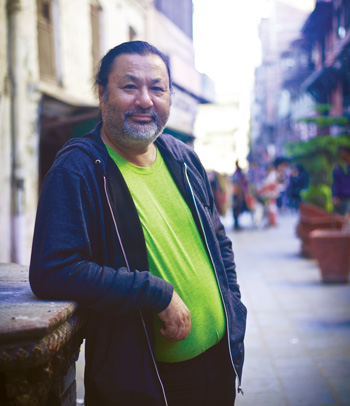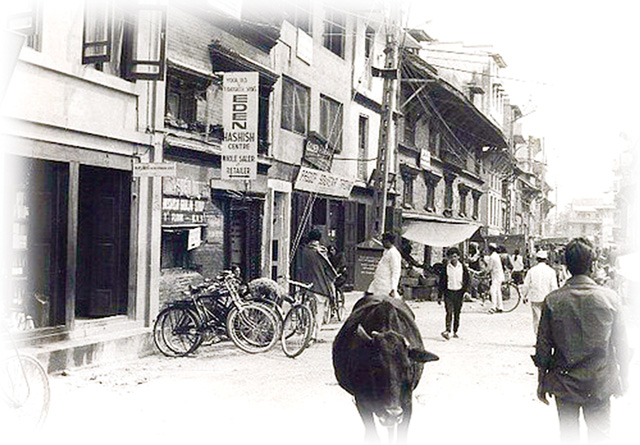Ever wondered why that one street off Basantapur is called “Freak Street”? We sit down with Mr. Shyam Kakshyapati, owner of the Nanglo chain of restaurants, who grew up in the midst of the hippy craze in Nepal, to find out how Jhochhen acquired its unique name.
 The seventies were a magical time in Nepal. There were few vehicles, no pollution, no over population. Everything was cheap, and the city still seemed untouched by time. It was all these factors that first attracted the weary flower children of the 60’s and 70’s to Kathmandu city.
The seventies were a magical time in Nepal. There were few vehicles, no pollution, no over population. Everything was cheap, and the city still seemed untouched by time. It was all these factors that first attracted the weary flower children of the 60’s and 70’s to Kathmandu city.
The whole hippy movement started off in the 60’s with youngsters who were sick of the constant war and power struggle going on in the greater world and wanted an escape. All they sought was peace and quiet, and maybe a time machine back to simpler times. And, late in the 60’s, many of them found this and more in a little known city called Kathmandu.
According to Mr. Kakshyapati, before the hippy movement, the only foreigners who came to Nepal were mountaineers and diplomats. Tourism was virtually non-existent. There were no hotels or restaurants. But, once Nepal was discovered by the wider world, travel vans filled with hippies started pouring into the valley.
“Most of these tourists were over-landers. They would drive all across Europe and Asia for weeks and weeks and come to Nepal through India in their travel vans and buses. Rarely did they come by flight. I remember that area used to be filled to the brim with tourist vehicles,” he recalls, pointing at the open space now filled with crafts-ware stalls in Basantapur, right outside of Himalayan Java.
“Back in ’68, Jhochhen was nothing. There were no hotels, no restaurants,” adds Mr. Kakshyapati, who grew up right in the middle of Freak Street. “It was around ’68 that a guy called Ravi from India opened up the first restaurant in Jhochhen. It was called Ravi’s Spot.” It was after the restaurant opened, that the first tourists started coming in, and as a result, some more restaurants started opening up as well.
“It was in the year ’69 that the first lodge started in Jhochhen. It was called Oriental Lodge.” And as the movement of tourists kept on increasing, more lodges and restaurants started popping up in the Jhochhen area. “I remember, after Oriental, more lodges like Annapurna Lodge, Juicy Lodge, etc. also opened up. And as more lodges opened up, more tourists started coming in.” By the year ’70, there were many, many, lodges and restaurants in Jhochhen.
But it was not just the untouched appeal of Kathmandu city that attracted these flower children. “Back in those days, marijuana and hashish were legal in Nepal. You could get a license and just open up a shop. Even restaurants had menus with items like ganja cake and hashish cake, and drinks with weed in them, because they so appealed to these tourists.”
“During that time, many of the hippies came here because of the free availability of hashish and marijuana, and because things were very cheap here. The food and the lodges were very cheap for them, which was a very big attraction. These people had all the time in the world. They would travel here on buses, and stay for a long time at very little cost. ”
Reminiscing further, he adds, “This was how Nepal became an attractive tourist destination, and Jhochhen became the center of it all. Later, they even changed the name to “Freak Street”, because all the freaks would hang out here. And, over there at Maruhiti, that place used to be called “pig alley” by the tourists, because the people there used to raise pigs, which would run around freely on the streets.”

The entire Jhochhen and surrounding area had become a hub for the hippy movement in Nepal by the seventies. It was a colorful time. All kinds of people, flower children, journalists, even celebrities, used to come and stay in Jhochhen. Mr. Kakshyapati remembers that time when Cat Stevens, the singer who later wrote a song about Kathmandu, stayed in Freak Street. Even Charles Shobraj, the notorious serial killer, stayed in Jhochhen around that time.
His best memories of those days were of hanging out at these restaurants, enjoying the music and the ambiance, and interacting with these tourists. “There was this very popular restaurant called the Pleasure Room where they had the best of the music. The ambiance was dark, with psychedelic colors. It was like heaven for these people,” he remembers. He also fondly remembers the full moon parties at Swoyambhu. Every full moon, around 100-150 people could be found hanging around Swoyambhu with guitars. They would sing and dance and play musical instruments and just enjoy themselves.
The hippy movement in Nepal went on till the late seventies. Back in those days, every other house was a lodge in and around Jhochhen. And, soon enough, it spread to the surrounding places, too, as Jhochhen did not have enough space to hold all these people on its own. And though Jhochhen did not grow as big as Thamel later did, it has certainly left its mark in Nepal’s tourism industry.
Mr. Kakshyapati believes that it was this movement of hippy tourists that first jump-started tourism in Nepal. Even the Department of Tourism was located in Basantapur, before it became a Ministry of Tourism. “The tourists could come to the Department of Tourism for information, and all the lodges and restaurants were right next door. So, all the touristic activities were then focused in this area.”
Slowly, in the late ’70’S, the hippy movement died down, but Nepal first became famous because of this movement, he states. Even people who weren’t part of this movement came to Nepal seeking some adventure, and they found it. Trekking started becoming popular, people started recognizing our culture, and Nepal became a known tourist destination. But all of this would not have been possible if the flower children of the 60’s and 70’s had not discovered Nepal.











